Power Chords ( Fifth Chords ) Fingering And Techniques
Power Chords are an important aspect of playing rock/metal guitar and they are probably one the easiest chords to play. These chords are very versatile and can provide a harmonic texture to most songs. On top of that, they can be played anywhere on the neck.
The power chords are also commonly known as the fifth (5th) chords and are usually denoted like this – G5, C5, D5 etc… It consists of a root and a perfect 5th interval and can be derived from the major scale.
The root (note that determines the name of the chord) is the lowest note that is played. To illustrate this, let’s use the C major scale to derive the C5 power chord.

The C5 power chord contains 2 notes : C and G. This is how it would look in tablature form.

Try playing the C power chord with both 2 notes and 3 notes. In the 3 notes form of the power chord, the root note is played with an octave for a fuller and sharper-sounding tone. If you want your guitar to sound heavier, stick with the 2 notes power chord. Typically, they are played on the thicker strings (5th & 6th) with distortion to give it the extra crunch and rock sound.
2 Note Power Chords Fingering
For the 2-note power chord, you should ideally use your index finger to fret the root note and place your pinky finger to fret the other.
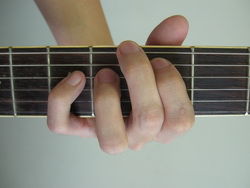
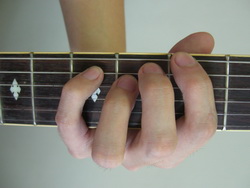
From the top view, the 2 notes power chords look like this.
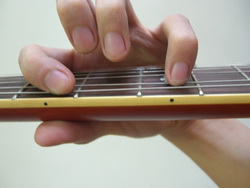
Let’s go through a simple practice exercise you can do to get the hang of things and get your fingers used to power chords. Try switching from a chord on the 5th string to the 6th string directly above it. When you do so, make sure that all the notes being played sound out clearly. On the other hand, those notes which aren’t supposed to ring should always stay muted when you are changing chords.
3 Note Power Chord Fingering Position
For the 3-note power chord, you should use the index finger to fret the root note. Then, use your ring finger and pinky to fret the rest of the chord as shown in the photographs below.
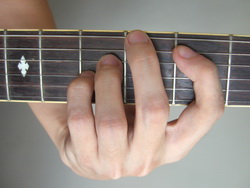
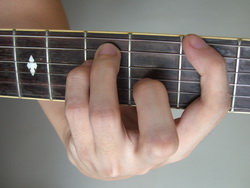
Alternatively, you can hold a minor barre chord and you can get the same effect as playing a power chord by strumming ONLY the bottom 3 strings.
Tips to Fretting Power Chords
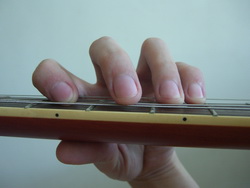
When playing power chords on the 5th string, I want you to take note of how I am using my middle finger to mute the 6th string. Simply rest your middle finger on the 6th string and it will help improve the tone of your power chords by eliminating unwanted noise.
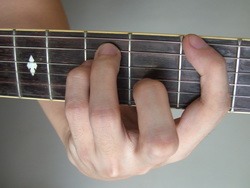
Also, notice how my index finger is curled. I used the curled index finger to fret the root note while muting the rest of the higher strings with the bottom part of my index finger. Again, this will eliminate unwanted sounds during strumming.
Power Chords Exercise
In a nutshell, power chords are very much similar to barre chords. They are movable chords that enable you to perform fast chord switching.
With good fingering combined with guitar techniques, power chords can be combined with palm muting and harmonics to create awesome effects. Be sure to check out the video below for more details…







Leave A Comment